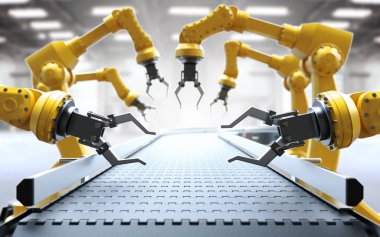The Role of Robotics in Modern Industries

Robots play a crucial role in modern industries by significantly increasing efficiency, productivity, and precision in manufacturing, logistics, and even healthcare. They perform dangerous, repetitive, or complex tasks with consistent accuracy, improve quality control, enhance worker safety, and contribute to innovations like surgical robotics and autonomous vehicles. Advancements in artificial intelligence (AI) and machine learning are making robots more adaptable and capable of working alongside humans, transforming industrial landscapes and creating new opportunities. Robotics has moved far beyond science fiction — it is now a core part of industries worldwide. From factory automation to healthcare assistance, robots are transforming productivity, safety, and innovation. Their role continues to expand as technology advances in AI, machine learning, and IoT (Internet of Things).
Manufacturing & Automation
Robots perform tasks like welding, painting, assembly, and material handling with high precision and speed.
Assembly Lines: Robots perform repetitive tasks with speed and precision.
Quality Control: Machine-vision robots detect defects faster than humans.
Collaborative Robots (Cobots): Work alongside humans to increase efficiency.
Healthcare & Medicine
Surgical robots enable minimally invasive procedures, while robots are used in drug formulation and quality control in the pharmaceutical industry
- Surgical Robots: Allow minimally invasive and highly precise surgeries.
- Rehabilitation Robotics: Assist patients in physical therapy and recovery.
- Service Robots: Help with patient care, medication delivery, and elderly support.

Logistics & Supply Chain
Robots automate warehouse operations, inventory management, order picking, and transportation.
Automated Warehouses: Robots like those in Amazon’s fulfillment centers optimize storage and shipping.
Autonomous Delivery: Drones and self-driving robots reduce delivery times.
Inventory Management: Robotics paired with AI ensures real-time tracking.
Agriculture

Automated Harvesting: Robots pick crops efficiently and reduce labor shortages.
Smart Drones: Monitor soil, water levels, and crop health.
Precision Farming: Robotics improves yield while reducing waste.
Construction & Infrastructure
Robots are making construction safer, faster, and more efficient.
- 3D Printing Robots: Capable of building entire houses in a matter of days.
- Heavy Machinery Automation: Robotic cranes and excavators reduce the risk of human accidents.
- Inspection Robots: Drones and crawlers inspect bridges, tunnels, and pipelines for cracks or damage.
Service & Hospitality Industry

Service robots are becoming increasingly common in customer-facing industries.
- Robotic Waiters & Receptionists: Hotels and restaurants use robots to serve food and guide guests.
- Cleaning Robots: From malls to hospitals, cleaning robots maintain hygiene and safety.
- Customer Engagement Robots: Interactive robots provide information in airports and museums.
Drivers of Robotic Integration
Efficiency & Productivity:
Robots increase production rates and consistency by working tirelessly and reducing errors.
Precision:
They perform tasks requiring high degrees of accuracy, which is essential for quality in many industries.
Technological Advancements:
Artificial intelligence (AI), machine learning, and the Internet of Things (IoT) enable smarter, more adaptable robots.
Impact on Work and Industries

- Improved Worker Satisfaction: Robots handle tedious and dangerous tasks, allowing human employees to focus on more engaging and creative work.
- Meeting Demand: Robots help businesses meet growing customer demands for high-end, precise products efficiently and cost-effectively.
- Innovation: The integration of robotics opens new possibilities for innovation and customization in production processes.
Future Outlook of Robotics

- AI + Robotics Integration for smarter, autonomous decision-making.
- Robotics in Space Exploration (NASA, SpaceX, ISRO missions).
- Wider Use of Cobots to support human workers rather than replace them.
- Sustainability Applications to reduce waste and improve efficiency.
Robotics is no longer optional in modern industries — it’s a driving force of progress. While challenges exist, the benefits in efficiency, safety, and innovation are undeniable. The future of work will likely be a collaboration between humans and robots, combining creativity with precision.
The future of robotics is deeply tied to AI, automation, and sustainability.
- Smarter Robots: AI-powered robots will make independent decisions in real time.
- Space Exploration: NASA and SpaceX use robotic systems for planetary exploration.
- Human-Robot Collaboration: Future workplaces will combine robotic efficiency with human creativity.
- Sustainability: Robots will help reduce waste, conserve energy, and improve efficiency in green industries.
